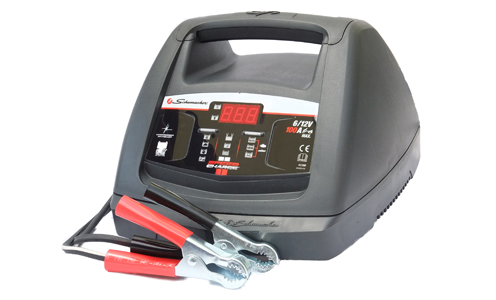
We’re all aware that battery technology has evolved over the years, from a battery that used to need weekly attention and a very limited lifespan, to a one that is sealed and will last up to five years.

But what is not so obvious is that battery charger technology has had to keep up with the pace of this development.
In a busy workshop or showroom what you want to do is to charge the battery as quickly as possible to get the vehicle on its way. Boost starting a car and relying on the vehicle’s charging system to charge the battery used to work, but now most vehicles have a ‘smart’ charging system that is only designed to replace the energy in the battery that it took to start the car, and will not fully recharge a discharged battery.
The other answer was to wheel out the big manual battery charger, remove the battery caps, connect the charger and, to quote Spinal Tap, ‘wind it up to 11’. This used to work well and the smell of rotten eggs was quite common as the electrolyte bubbled and gassed.
Quite obviously this method just will not work with a sealed maintenance-free battery of any type, as all that gas has got to escape, and in a sealed battery that could mean blowing the top off!
So the question is: ‘How can I safely charge a battery in the shortest possible time?’
Using a microprocessor-controlled charger is the obvious answer as it follows a pre-programmed charging algorithm that controls the charge input. There are a number of chargers available with this feature, with varying degrees of sophistication
The smarter of these chargers are able to maximise the charge input to minimise the time it takes to charge the battery, by bringing a number of other tools to the job. Each of the different battery types requires a slightly different charge programme and voltage input (pictured below).
| Battery type | Charging voltage |
| Calcium/Calcium | 15.8v – 16.0v |
| AGM/VRLA | 14.4v – 14.80v |
| Conventional/Deep Cycle | 14.4v – 14.0v |
| Gel | 14.2v – 14.4v |
The most sophisticated and fastest of these chargers takes into account a third factor: temperature. The programme actively balances the Amp and voltage inputs and regulates them to achieve 100% charge in the shortest time without the danger of gassing or thermal runaway (battery overheating).
The table (pictured below) shows the difference between the charging times of some conventional chargers and an intelligent ‘SpeedCharge’ equipped charger – the danger comes when the size of the conventional charger is increased without the control of the ‘Intelligent Charger’ as the charging time does not reduce significantly, but the danger of gassing does.
| Battery/size rating | Charge rate in Amps | |||
| 30 Amp | 50 Amp | Coventitional 10 Amp Charger | 12-30 Amp Speed Charger | |
| 40-50ah | 7-9hrs | 4-5hrs | 2-3hrs | 45mins-2hrs |
| 50-70ah | 9-12hrs | 5-7hrs | 3-4hrs | 1-3hrs |
| 70-100ah | 12-23hrs | 7-14hrs | 4-7hrs | 1-5hrs |









